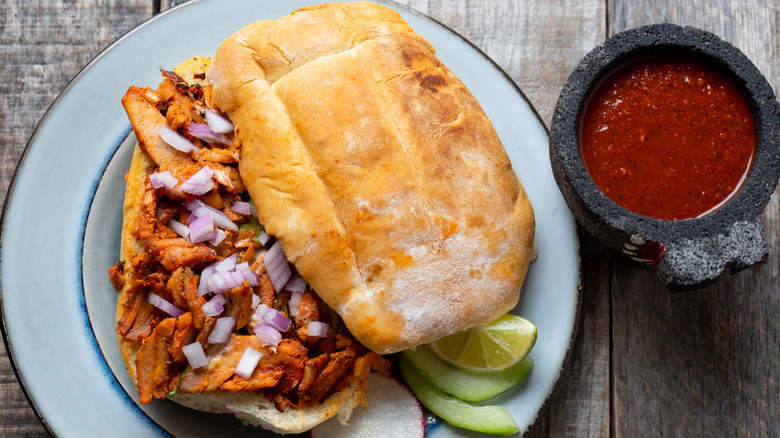What Is A Torta And How Do You Eat One?
Tortas have become increasingly popular north of the border in recent years. There's a very good chance you've seen them offered on the menu of a Mexican restaurant. And there's a similar chance that you've understood it to be a specific kind of sandwich, long popular in Mexico.
That name can, at least for those of us with minimal exposure to Spanish, be confusing. In Spanish, Italian, and other languages "torta" literally translates to "cake." What's more, there are other dishes that use the name in other countries, such as the Italian torta di ricotta e polenta, that are just that: cakes, commonly eaten for dessert.
In other contexts, however, the word has taken on other meanings. In Spain, it may refer to specific kinds of flatbread. In the Mexican context, however, the word has come to mean a particular sandwich. Most likely, when you order one in a Mexican restaurant, that is what the server will think to bring you. Likewise, the way you eat one is like any other sandwich (though there are is at least one exception).
With that in mind, you won't just be brought a few slices of luncheon meat slapped between slices of regular white bread with mayonnaise and tomato. The Mexican torta has a specific history. Traditionally, it also has specific breads and other ingredients associated with it, though restaurants and eateries are always finding new and unique fillings to add to their recipes.
French influence on the Mexican torta
Many of the torta's specifics have to do with the story behind it. Though the Mexican torta's exact origins are unknown, it is said that it originated during France's invasion and occupation of the country in the 1860s. The French occupation left an indelible mark on Mexican cuisine, as many of the latter country's rulers and upper classes sought to emulate the purported elegance of French culture, including in food.
This explanation seems to make sense given the types of bread typically used to make a torta, which normally calls for either a telera roll or bolillo bread. Though both are soft on the inside, the bolillo in particular has a crusty, crunchy outside, similar to a French baguette, though it is both shorter and rounder. True to its likely origins, some parts of Mexico will simply refer to it as "pan francés," literally French bread.
It would, however, be incorrect to simply chalk up the torta as merely a riff on the French bread sandwich. Yes, your bolillo or telera will be sliced in half and stuffed with fillings, but if it's a torta, then these fillings will be distinctly Mexican in flavor.
Meats, cheeses, veggies, and garnishes
Most tortas tend to be savory, meaning a great many of the savory meat preparations common in Mexican cuisine — chorizo, carne asada, al pastor pork, carnitas — will do well on your bolillo. One particularly popular filling is a milanesa, a chicken or beef cutlet, breaded and fried before it is put on your bread.
These different kinds of meat are just the start, though. Fried eggs are a common filling, as are refried beans, avocado, and all kinds of cheese, from queso fresco to cotija to Oaxacan. You can also check out our ultimate guide to Mexican cheeses for some ideas. As far as other vegetables you might want to add as a garnish, lettuce, tomato, and onion all make regular appearances on tortas. So do jalapeños, cilantro, and many different varieties of salsa.
One particularly indulgent variation hails from the Mexican state of Jalisco, and is called the torta ahogada. This literally translates to "drowned torta," and involves taking the finished sandwich and smothering it in a chile de arbol sauce. This is where you'll want to make an exception to your typical sandwich-eating method. Though you are welcome to try to eat a torta ahogada with your hands, a knife and fork will probably be a lot less messy.


